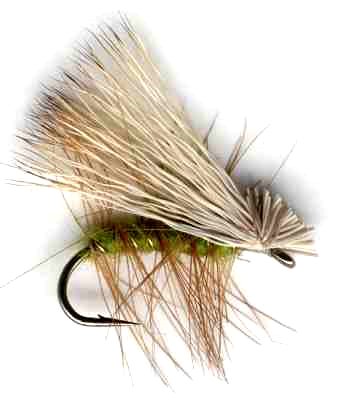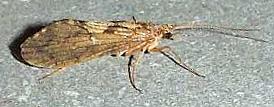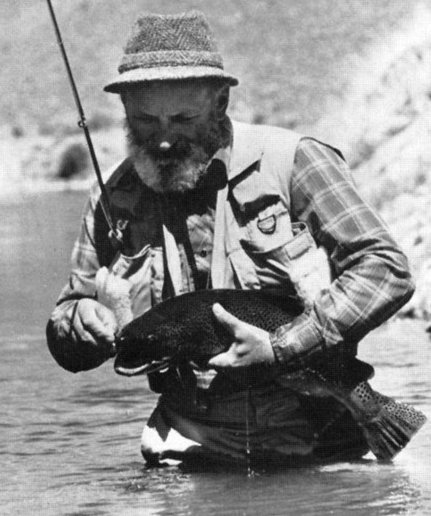Olive Elk Hair Caddis (Sedge) Fly
The Elk Hair Caddis design creates a wedge shaped wake as it is retrieved on the surface. This mimics the natural adult Caddis insect that has just hatched and who's wings have dried enough for it to attempt a take off along the water surface.

CADDIS FLY PATTERNS. Hook size 10 12 14 16 18 20 - $US each
As the just hatched adult caddis flies run along the top of the water film to try and get airborne. The distinctive ripples they make are big indicators to waiting hungry trout that food is moving on the surface. It is dinner time. They are quick to react and are on the look out for more emerging Caddis. I like to take a small fine mesh pond net when I visit a new river, stream or lake. I dislodge a few stones and position the net downstream and examine what has been disturbed. You can also pick up submerged stones or branches and examine what is attached. This is where caddis larvae live to live as they can find food and shelter. This is an easy way to find out what is available for the trout to feast on in the subsurface aquatic stage and later on as a hatch. This way you can plan what to keep in your fly box. Caddis like firm river beds and you will not find them in unstable soft bottoms. Do not touch naked caddis larvae with your hands because your body heat will soon kill them. Cased Caddis can be placed in your hand for a short while without casing damage.
Some female adult caddis crawl below the water surface and lay their eggs in small groups, rows or sheets. The Larva does not make a protective outer case. It drifts along the river bed looking for food. As it grows it sheds its skin four times. When it is fully grown it makes a shelter it sheds its skin for the last time and turns into a pupa. The adult insect forms within the pupa skin. When ready to emerge it cuts its way out of the pupa case and swims to the surface or river bank. to hatch into the flying adult form. The majority of egg laying female caddis just dip their tails into the water and squirt out the eggs to form a jelly blob under, on to or near the water. Their larva does make a portable case around the rear 2/3rds of its body that is sticky and is quickly covered with the debris that is found on the river or lake bed. This way the larva obtains protected camouflaged shelter from predators. They are known as cased caddis of which there are many wet fly imitations. It also molts its skin four times before sealing the front end of its case, molting its skin again and turning into a pupa.

When the adult caddis breaks through the water surface the most important thing on its mind is to get airborne as fast as it can. If it stays too long sitting in the water surface film waiting for its wings to dry it will be fish food. During a hatch large trout just 'hoover' them up by opening their mouths and sucking in the surface water. If your cast isn't perfect and the fly does not land vertical do not worry. Flying caddis mate and fall to the ground locked together, to complete the fertilisation of the eggs. Sometimes they fall into the water and drown. A semi submerged Elk Hair Caddis fly on its side will imitate one of these unfortunate adult flies. Don't retrieve it to to try and make the V shaped wake. Give it a few small tweaks to imitate a struggling exhausted caddis trying to get out of the water. If you notice a number of female caddis dipping their tails into the water laying eggs be assured that the waiting trout would also have noticed and are on the lookout. Try a few spot casts. Cast your fly then quickly lift it off. Repeat the action near the same area. Copy what the females are doing. Hopefully you may stimulate a take.

Fly Fisherman Al Troth designed the popular Elk Hair Caddis dry fly
LINKEDIN COMMENT
I lived in Arizona and fished for Carp in Oak Creek, I found out that I could catch them on an Elk Hair Caddis, No movement, cast in front of cruieing fish and often they would take. - By Mike Guinn
FACEBOOK COMMENT
I'll never grow tired of fishing my favorite Catskills water even in Chilly April. With every set back it keeps coming back stronger than ever. Today was and impressive hatch of Hendricksons , Blue Quills and a blanket of caddis in a size 18 to start the day. It was beautiful day to be on the water for sure a light breeze and a high of 52 ,the water made it to about 45 degrees a bit chilly but it didn't deter the fish. Kenny Murphy, New York



Fly Fishing books

